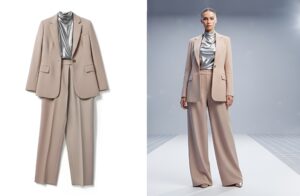In the language of fashion, nothing is more persuasive than motion. The subtle drape of a trench coat, the kinetic energy of a pleated skirt, or the way a fabric catches the light as a body moves—these are the details that build desire and inspire confidence. Yet, for too long, the digital storefront has been a museum of static, lifeless images, forcing customers to rely on guesswork to visualize these critical details.
This disconnect isn’t just an inefficiency; it’s a silent killer of conversions and a primary driver of returns. The solution? A new era of technology that is fundamentally reshaping how brands tell their product stories. Enter the AI clothing model generator—a revolutionary tool that transforms static product photos into dynamic, lifelike videos, putting motion back at the heart of e-commerce.
Platforms like EngageReel are not just selling a product; they are offering a new blueprint for fashion marketing and operations. This guide will explore why this technology is a non-negotiable for modern brands, what to look for in a best-in-class AI solution, and how it’s already driving measurable business outcomes across the industry.
The Industry’s Biggest Bottleneck: From Static to Stagnant
For years, fashion’s digital presence has been a compromise. Brands understood the power of video, but the cost and complexity of producing content for every single SKU were prohibitive. This reality created a content paradox: the assets that drive the most engagement and conversions were the very ones that were the most difficult to create at scale.
This reliance on static imagery alone has led to three critical business pain points:
- Conversion Friction & Cart Abandonment: Shoppers want to see how an item moves, fits, and feels. When they can’t, uncertainty creeps in. This lack of visual information is a major contributor to high cart abandonment rates, as customers hesitate to commit to a purchase when they can’t fully picture the product on themselves.
- Soaring Return Rates: The “looks-different-in-person” phenomenon is an industry-wide crisis. Returns in fashion can hover between 20-40%, driven largely by customers taking a chance on an item that doesn’t meet their expectations. These returns are a logistical and financial drain, eating into profits and creating unnecessary waste.
- Creative Gridlock: The traditional photoshoot process—hiring talent, booking studios, managing logistics, and enduring weeks of post-production—is a massive undertaking. This creative gridlock forces brands to prioritize a small selection of “hero” products, leaving the majority of their catalog to languish with underperforming assets. It also severely limits the speed at which a brand can react to trends or launch new collections.
This is precisely the challenge AI clothing model generators were built to solve. They don’t just fill a gap; they completely redefine what’s possible for creative teams.

Democratizing the Runway: What an AI Clothing Model Generator Does
At its core, an AI clothing model generator is a technology that leverages advanced generative AI to simulate how garments look and move on digital models. The process is a seamless blend of art and science:
- Input: A brand uploads existing static product photos, whether they are on-model shots, flat-lays, or even mannequin images.
- Analysis: The AI analyzes the garment, its fabric, and its unique properties. It understands the texture of silk, the weight of denim, and the drape of a wool knit.
- Generation: The AI then brings the garment to life, animating it on a diverse range of models in various poses and environments. This happens in minutes, not weeks.
- Output: The result is a high-quality, conversion-optimized video that can be used on product detail pages (PDPs), marketplaces, or across social media channels.
This isn’t just about automating a process; it’s about democratizing video production. It allows even mid-sized D2C brands to produce content that rivals the output of global players, without draining resources.
From Studio to Screen: A Shift in Fashion Content Production
For decades, the studio shoot was a cornerstone of fashion marketing. It was a high-stakes, high-cost affair reserved for flagship campaigns. Today, that paradigm is shifting.
| Traditional Studio Production | AI-Driven Production with EngageReel |
| Cost: High (talent, crew, location, equipment) | Cost: A fraction of studio budgets |
| Time: Weeks to months | Time: Minutes to hours |
| Scale: Limited, costly per SKU | Scale: Unlimited, democratized |
| Sustainability: High (travel, samples, waste) | Sustainability: Low (virtual-only) |
This fundamental change in production is leading to real, measurable business outcomes that go straight to the bottom line.
Tangible Outcomes: How AI Drives Real Business Results
The benefits of AI-generated videos aren’t just theoretical; they are backed by powerful data:
- Up to 3X Higher Conversions: When shoppers see a dress flow or a shirt stretch, their uncertainty vanishes. This immediate boost in buyer confidence directly translates to a significant lift in conversion rates.
- Up to 50% Fewer Returns: By providing a richer, more accurate product experience, AI-generated videos help customers make the right decision the first time. This not only cuts down on returns but also enhances customer satisfaction and loyalty.
- Creative Agility & Speed: The ability to generate unlimited video variations instantly allows brands to be more agile. Launching a new collection, testing new formats for TikTok, or running A/B tests on a product page are all now possible without the traditional bottlenecks.
- Sustainability by Default: By eliminating the need for physical samples and energy-heavy shoots, AI-driven production reduces waste and aligns with the growing demand for more sustainable practices among conscious consumers.
EngageReel: The AI Partner Built for Fashion, Not Just Video
While the market is seeing a new wave of AI video startups, few understand the specific nuances and demands of the fashion industry. EngageReel was purpose-built for apparel and accessories, with a sharp focus on the details that truly matter.
Here’s why leading fashion brands, from mid-sized D2C players to global retailers, choose EngageReel as their partner:
- Domain Expertise: Our AI models are specifically trained on a vast library of fabrics, textures, and garments. This ensures the output is not a generic visual but an accurate, high-fidelity representation of your product.
- Proven ROI: Unlike tools that promise generic video, EngageReel is engineered for results. Our focus is on the PDP video, where conversions are won or lost. Our track record of driving higher conversions and reducing returns speaks for itself.
- Seamless Integration & Speed to Market: EngageReel integrates effortlessly with your existing workflow, allowing you to go from product photo to high-converting video in minutes. This is critical for scaling across multiple channels, including Shopify, marketplaces, and global campaigns.
Looking Ahead: The Motion-First Future of E-commerce
The future of fashion commerce isn’t about the products themselves; it’s about the experience of discovering and purchasing them. As shoppers become more discerning and AI platforms like Google and LLMs prioritize immersive content, the brands that embrace motion will lead, and those that remain static will fade.
AI clothing model generators aren’t replacing human creativity; they are amplifying it. They free up fashion teams to focus on brand storytelling, trend forecasting, and strategic innovation—while AI handles the scalable, heavy-lifting of content production. The question for every fashion business leader isn’t if the industry will adopt this technology, but how quickly their brand will lead the change.
Final Thoughts
Fashion has always been about more than clothes; it’s about the energy, emotion, and story that garments embody. With AI clothing model generators, brands can finally capture and deliver that experience online, at scale.
Platforms like EngageReel are a powerful enabler, allowing you to turn static product photos into high-converting videos, building shopper confidence and driving sustainable, profitable growth.
The motion-first future is here. Are you ready to lead it?





